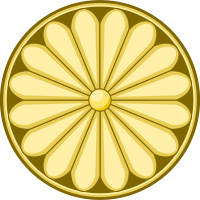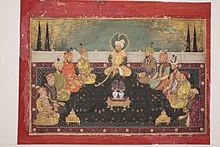Mughal dynasty
| House of Babur | |
|---|---|
 Imperial seal of the Mughal dynasty | |
| Parent house | Timurid |
| Country | Mughal Empire |
| Founded | 21 April 1526 |
| Founder | Babur |
| Final ruler | Bahadur Shah II |
| Titles | List
|
| Traditions | Sunni Islam (1526-1857) and Din-i Ilahi (1582-1605) |
| Deposition | 21 September 1857 (164years 6 months) |
The Mughal dynasty (Hindustani: मुग़ल ख़ानदान/مغل خاندان; romanized: Mug̱ẖāl Kẖāndhān) was made up of the members of the imperial House of Babur (Hindustani: बाबर का परिवार; romanized: Bābar kā parivār/ خاندانِ آل بابر; romanized: Kẖāndhān-ı Āl-i ʿBābuŕ), also known as the Gurkanis (Persian: گورکانیان; Gūrkāniyān).[1] The Mughals were a branch of the Timurid dynasty of Turco-Mongol origin from Central Asia. The dynasty's founder, Babur, was a direct descendant of the Asian conqueror Timur on his father's side and of Mongol emperor Genghis Khan on his mother's side, and Babur's ancestors had other affiliations with Genghisids through marriage and common ancestry.[2] The term "Mughal" is itself a corrupted form of "Mongol" in the Arabic and Persian languages, as it emphasised the Mongol origins of the Mughal dynasty.[3] The Mughal dynasty ruled the Mughal Empire from c. 1526 to 1857.
During much of the Empire's history, the emperor was the absolute head of state, head of government and head of the military, while during its declining era much of the power shifted to the Grand Vizier and the empire was divided into many regional kingdoms and princely states.[4] But even in the declining era, the Mughal Emperor continued to be the highest manifestation of sovereignty on the Indian subcontinent. Not only the Muslim gentry, but the Maratha, Rajput, and Sikh leaders took part in ceremonial acknowledgements of the emperor as the sovereign of South Asia.[5] The imperial family was deposed from power and the empire was abolished on 21 September 1857 during the Indian War of Independence. The British Raj was declared the following year.
The last emperor Bahadur Shah II was exiled to Rangoon in British-controlled Burma (now Myanmar), after being convicted on several charges.[6]
History[]
The Mughal empire is conventionally said to have been founded in 1526 by Babur, a Timurid prince from what today is Uzbekistan. After losing his ancestral domains in Central Asia, Babur first established himself in Kabul and ultimately moved towards the Indian subcontinent.[7] Mughal rule was interrupted for 16 years by the Sur Emperors during Humayun's reign.[8] The Mughal imperial structure was founded by Akbar the Great around the 1580s which lasted until the 1740s, until shortly after the Battle of Karnal. During the reigns of Shah Jahan and Aurangzeb, the dynasty reached its zenith in terms of geographical extent, economy, military and cultural influence.[9]
Around 1700, the dynasty was ruling the wealthiest empire in the world, with also the largest military on earth.[10] Mughals had approximately 24 percent share of world's economy and a military of one million soldiers.[11][12] At that time the Mughals ruled almost the whole of the South Asia with 160 million subjects, 23 percent of world's population.[13] The Dynasty's power rapidly dwindled during 18th century with internal dynastic conflicts, incompatible monarchs, foreign invasions from Persians and Afghans, as well as revolts from Marathas, Sikh, Rajputs and regional Nawabs.[14][15] The power of the last emperor was limited only to the Walled city of Delhi.
Many of the Mughals had significant Indian Rajput and Persian ancestry through marriage alliances as they were born to Rajput and Persian princesses.[16][17] Mughals played a great role in the flourishing of Ganga-Jamuni tehzeeb (Indo-Islamic civilization).[18] Mughals were also great patrons of art, culture, literature and architecture. Mughal painting, architecture, culture, clothing, cuisine and Urdu language; all were flourished during Mughal era. Mughals were not only guardians of art and culture but they also took interest in these fields personally. Emperor Babur, Aurangzeb and Shah Alam II were great calligraphers,[19] Jahangir was a great painter,[20] Shah Jahan was a great architect[21] while Bahadur Shah II was a great poet of Urdu.[22]
Succession to the Throne[]

The Mughal dynasty operated under several basic premises: that the Emperor governed the empire's entire territory with complete sovereignty, that only one person at a time could be the Emperor, and that every male member of the dynasty was hypothetically eligible to become Emperor, even though an heir-apparent was appointed several times in dynastic history. The certain processes through which imperial princes rose to the Peacock Throne, however, were very specific to the Mughal Empire. To go into greater detail about these processes, the history of succession between Emperors can be divided into two eras: Era of Imperial successions (1526-1713) and Era of Regent successions (1713-1857).
References[]
- ^ Zahir ud-Din Mohammad (10 September 2002). Thackston, Wheeler M. (ed.). The Baburnama: Memoirs of Babur, Prince and Emperor. New York: Modern Library. p. xlvi. ISBN 978-0-375-76137-9.
In India the dynasty always called itself Gurkani, after Temür's title Gurkân, the Persianized form of the Mongolian kürägän, 'son-in-law,' a title he assumed after his marriage to a Genghisid princess.
- ^ Berndl, Klaus (2005). National Geographic Visual History of the World. National Geographic Society. pp. 318–320. ISBN 978-0-7922-3695-5.
- ^ Dodgson, Marshall G.S. (2009). The Venture of Islam. Vol. Volume 3: The Gunpowder Empires and Modern Times. University of Chicago Press. p. 62. ISBN 978-0-226-34688-5.
{{cite book}}:|volume=has extra text (help) - ^ Sharma, S. R. (1999). Mughal Empire in India: A Systematic Study Including Source Material. Atlantic Publishers & Dist. ISBN 978-81-7156-817-8.
- ^ Bose, Sugata; Jalal, Ayesha (2004). Modern South Asia: History, Culture, Political Economy (2nd ed.). Routledge. p. 41. ISBN 978-0-203-71253-5.
- ^ Bhatia, H.S. Justice System and Mutinies in British India. p. 204.
- ^ Eraly, Abraham (2007), Emperors of the Peacock Throne: The Saga of the Great Moghuls, Penguin Books Limited, ISBN 978-93-5118-093-7
- ^ Kissling, H. J.; N. Barbour; Bertold Spuler; J. S. Trimingham; F. R. C. Bagley; H. Braun; H. Hartel (1997). The Last Great Muslim Empires. BRILL. pp. 262–263. ISBN 90-04-02104-3. Retrieved 17 May 2020.
- ^ "BBC - Religions - Islam: Mughal Empire (1500s, 1600s)". www.bbc.co.uk (in British English). Retrieved 2020-06-15.
- ^ Lawrence E. Harrison, Peter L. Berger (2006). Developing cultures: case studies. Routledge. p. 158. ISBN 9780415952798.
- ^ Maddison, Angus (25 September 2003). Development Centre Studies The World Economy Historical Statistics: Historical Statistics. OECD Publishing. pp. 256–. ISBN 978-92-64-10414-3.
- ^ Art of Mughal Warfare." Art of Mughal Warfare. Indiannetzone, 25 Aug. 2005.
- ^ József Böröcz (2009-09-10). The European Union and Global Social Change. Routledge. p. 21. ISBN 9781135255800. Retrieved 17 May 2020.
- ^ Hallissey, Robert C. (1977). The Rajput Rebellion Against Aurangzeb. University of Missouri Press. pp. ix, x, 84. ISBN 978-0-8262-0222-2.
- ^ Claude Markovits (2004) [First published 1994 as Histoire de l'Inde Moderne]. A History of Modern India, 1480–1950. Anthem Press. pp. 172–173. ISBN 978-1-84331-004-4.
- ^ Duindam, Jeroen (2016). Dynasties: A Global History of Power, 1300–1800. Cambridge University Press. ISBN 978-1-107-06068-5.
- ^ Mohammada, Malika (2007). The Foundations of the Composite Culture in India. Aakar Books. ISBN 978-81-89833-18-3.
- ^ Alvi, Sajida Sultana (2012-08-02). Perspectives on Indo-Islamic Civilization in Mughal India: Historiography, Religion and Politics, Sufism and Islamic Renewal. OUP Pakistan. ISBN 978-0-19-547643-9.
- ^ Taher, Mohamed (1994). Librarianship and Library Science in India: An Outline of Historical Perspectives. Concept Publishing Company. ISBN 978-81-7022-524-9.
- ^ Dimand, Maurice S. (1944). "The Emperor Jahangir, Connoisseur of Paintings". The Metropolitan Museum of Art Bulletin. 2 (6): 196–200. doi:10.2307/3257119. ISSN 0026-1521. JSTOR 3257119.
- ^ Asher 2003, p. 169
- ^ Bilal, Maaz Bin (2018-11-09). "Not just the last Mughal: Three ghazals by Bahadur Shah Zafar, the poet king". DAWN.COM. Retrieved 2020-06-24.
Notes[]
- Asher, Catherine Ella Blanshard (2003) [First published 1992]. Architecture of Mughal India. The New Cambridge History of India. Vol. Volume I:4. Cambridge University Press. p. 368. ISBN 978-0-521-26728-1.
{{cite book}}:|volume=has extra text (help)
- Mughal dynasty
- Mughal Empire
- Mughal emperors
- Mughal nobility
- Maturidis